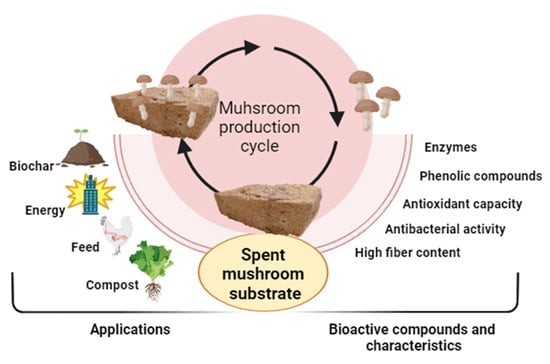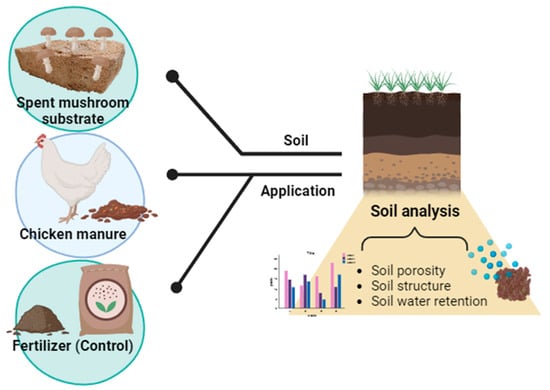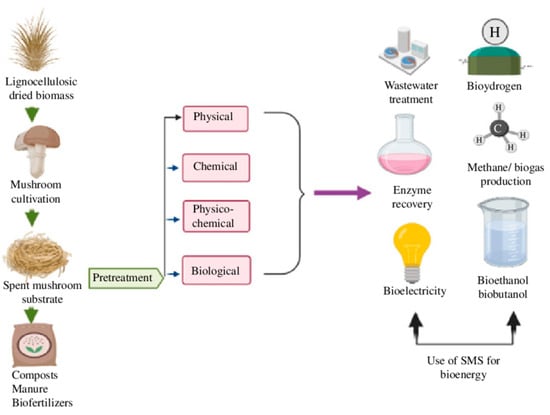You're using an outdated browser. Please upgrade to a modern browser for the best experience.
Please note this is a comparison between Version 1 by Filipa Baptista and Version 2 by Peter Tang.
As the mushroom industry advances, it yields a consequential by-product known as spent mushroom substrate (SMS). Comprising residual fungal mycelium, lignocellulosic biomass, and enzymes, SMS has garnered significant attention as a substantial waste product.
- spent mushroom substrate
- antioxidant
- antibiotic
- fertilizer
1. Introduction
The taxonomy of mushrooms currently encompasses a vast array of fungi, comprising approximately 12,000 species, among which more than 2000 species are distinguished as edible and possess therapeutic attributes, resulting in their widespread consumption [1][2][3][1,2,3]. In 2018, the global mushroom market achieved a notable volume of around 13 million tons, with projections indicating a substantial growth to 21 million tons by 2026 [4][5][6][7][4,5,6,7].
As the mushroom industry advances, it yields a consequential by-product known as spent mushroom substrate (SMS). Comprising residual fungal mycelium, lignocellulosic biomass, and enzymes, SMS has garnered significant attention as a substantial waste product [7][8][9][7,8,9]. The composition of raw SMS can vary, with contents of up to 48.7% cellulose, 34% hemicellulose, and 39.8% lignin, contingent upon the source of the mushroom cultivation medium. SMS also serves as a source of essential vitamins and minerals, including iron, magnesium, zinc, and calcium. Moreover, it is remarkably rich in bioactive compounds, encompassing polysaccharides, polypeptides, and phenolics. SMS additionally harbors valuable enzymes; research has indicated that SMS from Lentinula edodes, Agaricus bisporus, and Pleurotus eryngii possesses enzymes such as β-glucanase, xylanase, laccase, and phytase [7].
However, as the edible mushroom sector thrives, SMS accumulates at a remarkable rate, approximately 5 kg for every kilogram of freshly harvested mushrooms, culminating in a staggering 60 million tons over a decade [5][7][5,7]. Regrettably, SMS frequently encounters disposal as agricultural waste, incurring substantial costs ranging from 10 to 50 EUR/ton in Europe, thus accumulating a considerable financial burden that could potentially surpass EUR 150 million annually for the industry [8]. The absence of sustainable disposal strategies emerges as a significant hindrance to the continued expansion of the mushroom industry [10]. Arguably, as illustrated in Figure 1, SMS enzyme extraction and bioactive compound potential emerge as promising avenues [11][12][11,12]. The incorporation of SMS as animal feed has been practiced for several decades, with P. ostreatus and L. edodes being used in ruminants [13]. Beyond ruminants, SMS integration into livestock, poultry, and fish diets enhances microbial balance and promotes growth [7]. SMS’s potential as a feed source is evident in various species [14], including insects (Beetle: Protaetia Brevitarsis; Mealworm: Tenebrio molitor) [15][16][15,16], rabbits (Cuban Brown: Oryctolagus cuniculus) [17], pigs (Sus scrofa domesticus) [18], and ruminants (Sika deer: Cervus nippon, Dairy cows: Bos taurus coreanae, Bos taurus) [19][20][21][19,20,21]. Similarly, to mushrooms’ fruiting bodies, whose biological activity is far more studied, SMS can exhibit nutraceutical properties worth studying, such as antioxidant capacity [22][23][24][22,23,24], antibacterial and antifungal activity [25][26][27][25,26,27], antiaging activity [28], and other health benefits [29].

Figure 1.
Mushroom production cycle and spent mushroom substrate bioactive compounds and main applications.
In the realm of agriculture, spent mushroom substrate (SMS) emerges as a compelling sustainable alternative to conventional chemical fertilizers and soil amendments, offering solutions to both energy consumption and environmental concerns [7][30][7,30]. Remarkably, even after undergoing multiple cycles of mushroom production, SMS retains its robust nutrient content and organic matter, rendering it an ideal choice for biofertilization and soil enhancement [10][31][10,31]. The distinctive qualities of SMS, including excellent air permeability, water and nutrient retention capabilities, and a loose texture, foster an improved ecological environment for soil microorganisms and enhance the physical structure of the soil, thereby minimizing plant stress and bolstering nutrient bioavailability [7][31][7,31]. Furthermore, SMS exhibits the capacity to fine-tune soil pH levels and mitigate soil contamination by various pollutants such as heavy metals, pesticides, and polycyclic aromatic hydrocarbons [31][32][31,32].
Beyond its applications in agriculture, SMS holds substantial promise in the realm of renewable energy production from agro-industrial biomass [30][33][30,33]. It seamlessly integrates into various bioenergy production methods, bolstering the generation of biomass fuels, biofuels, bioethanol, and biogas [30][34][30,34]. Co-digestion of SMS with other lignocellulosic biomass sources has displayed significant potential, particularly in the enhancement of methane and hydrogen production [30][34][30,34]. This collaborative approach not only advances renewable energy objectives but also contributes to cost reduction in operational processes [35]. Expanding its role, SMS emerges as a bioremediation contender, targeting environmental contamination through living organisms [36][37][36,37]. SMS from various mushroom species effectively removes pollutants like H2S, volatile compounds, and heavy metals, even degrading harmful compounds like polycyclic aromatic hydrocarbons and pesticides. This underscores SMS’s potential for remediating polluted soils and waters [32][36][38][32,36,38].
2. Alternatives to Conventional Fertilizers
Soil organic matter plays a central role in driving soil processes and functions and is a key resource base for agriculture. As demonstrated in Figure 2, it contributes to an improvement in soil structure, water retention, and quality. The incorporation of residual spent mushroom substrate that remains after the mushroom harvesting process, along with the poultry manure obtained from waste disposal has gained substantial endorsement for its advantageous role in agricultural recycling. This practice promotes the establishment of entirely natural nutrient and organic carbon cycles, aligning with the pursuit of enduring sustainability. Both organic materials hold significant value as constituents of composts. Their inherent alkaline characteristics contribute to the amelioration of soil acidity while simultaneously augmenting the accessibility of nutrients [39][41]. Furthermore, the utilization of poultry manure and litter extends to serving as a source of chemical energy for the generation of electricity and heat, whereas SMS finds application as a substrate for other mushroom-forming fungi and becomes integral to the production of biofuels and enzymes [40][42].
Figure 2. Effects of application of recycled chicken manure and spent mushroom substrate on organic matter, acidity, and hydraulic properties of sandy soils [40].
Effects of application of recycled chicken manure and spent mushroom substrate on organic matter, acidity, and hydraulic properties of sandy soils [42].
3. Renewable Energy and Gas Emissions
Spent mushroom substrate (SMS) and poultry waste stand as formidable allies in the battle against greenhouse gas emissions and environmental degradation. These organic resources hold immense promise, finding effective utilization avenues in composting processes, biogas production, and precision nutrient management strategies [53][54][55][59,60,61]. By redirecting these valuable waste streams away from landfills and harnessing their inherent attributes, we can take substantial strides towards sustainable waste management, climate change mitigation, and the promotion of a more robust ecosystem. The utilization of SMS and poultry waste unfolds an opportunity to tackle waste management challenges while concurrently reaping the rewards of environmental enhancement through resource recycling and the generation of renewable energy [53][54][55][59,60,61]. This is especially pertinent considering that these lignocellulosic agro-wastes represent accessible raw biomass that can be harnessed to produce biofuels and bioenergy. The process is thoughtfully elucidated in Figure 3.
Figure 3.
Sustainable utilization of spent mushroom substrate (SMS) for energy production.
4. Animal Nutrition
Spent mushroom substrate holds promising potential as a valuable ingredient in animal diets. SMS, derived from the cultivation of mushrooms, offers a rich source of nutrients and bioactive compounds that can benefit livestock nutrition and health. Studies have demonstrated the effectiveness of incorporating SMS in animal feed formulations. Notably, compounds like ellagitannins, lignans, isoflavones, and flavanones, which play a role in gut microbiota, are likely to provide health benefits in the gastro-intestinal tract. Additionally, the metabolites produced by gut microbiota from these compounds might contribute to the broader systemic effects associated with their parent compounds, as observed in Figure 4 [57][63].
